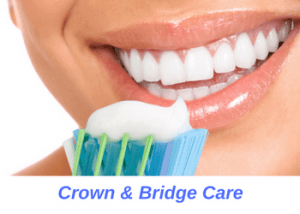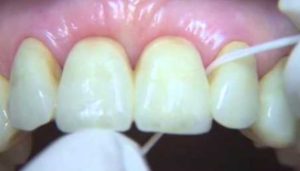Why is it important to care for your crowns and bridges?
Crowns and bridges are dental prostheses that restore broken and missing teeth. Most of us end up needing a few crowns or bridges in our lifetime. It's important to understand the limitations of crowns and bridges. Placing a crown or bridge on your teeth does not mean that the tooth is protected indefinitely. Teeth with crowns and bridges can still develop recurrent cavities, bone loss, or infections, just like any other tooth in your mouth! This explains why caring for your crowns and bridges is important to the long-term longevity of your teeth and dental prosthesis.

Teeth with crowns and bridges can develop cavities, bone loss, or infection just like any other tooth in your mouth
How should I clean my crowns and bridges?
You need to clean your teeth that have a crown and the ones with a bridge. Luckily, cleaning crowns is easier than cleaning bridges. Oftentimes, brushing and flossing your teeth is sufficient to clean teeth with crowns. If you're getting lots of food traped next to your crown, consider using a Waterpik or an interproximal cleaner. Cleaning bridges can be a bit more tricky. This is mainly because of the gap underneath the bridge where the missing tooth used to be. You need to use a device known as super-floss to properly clean bridges. Clean your bridge with a super-floss at least several times a week. Otherwise, food and plaque accumulate underneath the bridge and may damage the supporting teeth. If you're not sure how to use a super-floss, talk to your dentist for guidance.

You should clean your bridges using a super-floss at least several times a week
What if my crowns and bridges trap food?
It's not unusual for crowns and bridges to trap a bit more food as compared to natural teeth:
- If you’re getting a tiny bit of food trapped, consider using a Waterpik or interproximal cleaner to better clean your teeth. These special cleaning devices are designed to clean crowns and bridges. They are very effective at removing food particles trapped next to crowns and bridges when combined with proper brushing and flossing.
- If your crowns and bridges are trapping lots of food particles on a consistent basis, then you should consult with your dentist. Sometimes older crowns and bridges don't fit as well as they used to. This could be due to fractures, bone loss, tooth shifting, and other reasons. Food traps lead to cavities, bone loss, and even infection. You may have to replace crowns and bridges that are trapping lots of food particles. Consult with your dentist to see if there's another solution, or if it's time to replace your crowns and bridges with a better-fitting prosthesis.
To learn more about how to care for other dental prostheses, click on the following links: